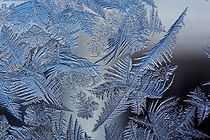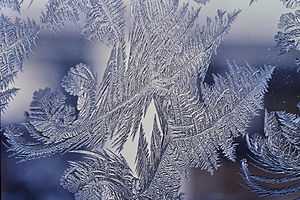Frost

Frost is the solid deposition of water vapor from humid air. It is formed when the temperature of a solid surface is below the freezing point of water and also below the frost point.[1] The size of frost crystals varies depending on the time they have been building up and the amount of water vapor available. Frost crystals are translucent, but scatter light in many directions, so that a coating of frost appears white. There are many types of frost, such as radiation and window frost. Frost may damage crops or reduce future crop yields, hence farmers may take measures to prevent it forming.
Formation
If a solid surface is chilled below the dew point of the surrounding air and the surface itself is colder than freezing, frost will form on the surface. Frost consists of spicules of ice which grow out from the solid surface. The size of the crystals depends on time, temperature, and the amount of water vapor available. Based on wind direction, "frost arrows" might form.
In general, for frost to form the deposition surface must be colder than the surrounding air. For instance frost may be observed around cracks in cold wooden sidewalks when moist air escapes from the ground below. Other objects on which frost tends to form are those with low specific heat or high thermal emissivity, such as blackened metals; hence the accumulation of frost on the heads of rusty nails. The apparently erratic occurrence of frost in adjacent localities is due partly to differences of elevation, the lower areas becoming colder on calm nights. It is also affected by differences in absorptivity and specific heat of the ground, which in the absence of wind greatly influences the temperature attained by the superincumbent air.
The formation of frost is an example of meteorological deposition.
Types
Hoar frost

Hoar frost (also called radiation frost or hoarfrost or pruina) refers to the white ice crystals, loosely deposited on the ground or exposed objects, that form on cold clear nights when heat is lost into the open sky causing objects to become colder than the surrounding air. A related effect is flood frost or frost pocket[2] which occurs when air cooled by ground-level radiation losses travels downhill to form pockets of very cold air in depressions, valleys, and hollows. Hoar frost can form in these areas even when the air temperature a few feet above ground is well above freezing. Nonetheless the frost itself will be at or below the freezing temperature of water.
Hoar frost may have different names depending on where it forms. For example, air hoar is a deposit of hoar frost on objects above the surface, such as tree branches, plant stems, wires; surface hoar is formed by fernlike ice crystals directly deposited on snow, ice or already frozen surfaces; crevasse hoar consists of crystals that form in glacial crevasses where water vapour can accumulate under calm weather conditions; depth hoar refers to cup shaped, faceted crystals formed within dry snow, beneath the surface.
The name hoar comes from an Old English adjective for showing signs of old age, and is used in this context in reference to the frost which makes trees and bushes look like white hair. It may also have association with hawthorn when covered in its characteristic white spring blossom.
Surface hoar is a cause of avalanches when it forms on top of snow. Conditions are ideal for the formation of hoarfrost on cold clear nights, with a very light wind that is able to circulate more humidified air around the snow surface. Wind that is too abrupt will destroy the crystals. When buried by subsequent snows they may remain standing for easy identification, or become laid down, but still dangerous because of the weakness of the crystals. In low temperatures surface hoar can also be broken apart and blown across the surface forming yukimarimo.
Hoar frost also occurs around man-made environments such as freezers or industrial cold storage facilities. It occurs in adjacent rooms that are not well insulated against the cold or around entry locations where humidity and moisture will enter and freeze instantly depending on the freezer temperature.
Advection frost
Advection frost (also called wind frost) refers to tiny ice spikes forming when there is a very cold wind blowing over branches of trees, poles and other surfaces. It looks like rimming the edge of flowers and leaves and usually it forms against the direction of the wind. It can occur at any hour of day and night.
Window frost
Window frost (also called fern frost or ice flowers) forms when a glass pane is exposed to very cold air on the outside and moderately moist air on the inside. If the pane is not a good insulator (such as a single pane window), water vapour condenses on the glass forming patterns. With very low temperatures outside, frost can appear on the bottom of the window even with double pane energy efficient windows. (Due to air convection between two panes of glass, the bottom part of the glazing unit is always colder than the top part.) The glass surface influences the shape of crystals, so imperfections, scratches, or dust can modify the way ice nucleates. If the indoor air is very humid, rather than moderately so, water will first condense in small droplets and then freeze into clear ice.
White frost
White frost is a solid deposition of ice which forms directly from water vapour contained in air. White frost forms when there is a relative humidity above 90% and a temperature below –8 °C (18 °F) and it grows against the wind direction, since arriving windward air has a higher humidity than leeward air, but the wind must not be very strong in order not to damage the delicately built icy structures. These structures resemble a heavy coating of hoar frost with big and interlocking crystals, usually needle-shaped.
Rime
Rime is a type of ice deposition that occurs quickly, often under conditions of heavily saturated air and windy conditions. Technically speaking, it is not a type of frost, since usually supercooled water drops are involved, in contrast to the formation of hoar frost, in which water vapour condenses slowly and directly. Ships travelling through Arctic seas may accumulate rime on the rigging. Unlike hoar frost, which has a feathery appearance, rime generally has an icy solid appearance.
Effect on plants
Overview

Many plants can be damaged or killed by freezing temperatures or frost. This varies with the type of plant, the tissue exposed, and how low temperatures get: a "light frost" of −2 to 0 °C (28 to 32 °F) will damage fewer types of plants than a "hard frost" below −2 °C (28 °F).[3]
Plants likely to be damaged even by a light frost include vines—such as beans, grapes, squashes, melons—along with nightshades such as tomatoes, eggplants and peppers. Plants that may tolerate (or even benefit) from frosts include:[4]
- root vegetables (e.g. beets, carrots, parsnips, onions)
- leafy greens (e.g. lettuces, spinach, chard)
- cruciferous vegetables (e.g. cabbages, cauliflower, bok choy, broccoli, Brussels sprouts, radishes, kale, collard, mustard, turnips, rutabagas)
Even those plants that tolerate frost may be damaged once temperatures drop even lower (below −4 °C or 25 °F).[3] Hardy perennials, such as Hosta, become dormant after the first frosts and regrow when spring arrives. The entire visible plant may turn completely brown until the spring warmth, or may drop all of its leaves and flowers, leaving the stem and stalk only. Evergreen plants, such as pine trees, withstand frost although all or most growth stops. Frost crack is a bark defect caused by a combination of low temperatures and heat from the winter sun.
Vegetation is not necessarily damaged when leaf temperatures drop below the freezing point of their cell contents. In the absence of a site nucleating the formation of ice crystals, the leaves remain in a supercooled liquid state, safely reaching temperatures of −4 to −12 °C (25 to 10 °F). However, once frost forms, the leaf cells may be damaged by sharp ice crystals. Hardening is the process by which a plant becomes tolerant to low temperatures. See also cryobiology.
Certain bacteria, notably Pseudomonas syringae, are particularly effective at triggering frost formation, raising the nucleation temperature to about −2 °C (28 °F).[5] Bacteria lacking ice nucleation-active proteins (ice-minus bacteria) result in greatly reduced frost damage.[6]
Protection methods

The selective inverted sink[7] prevents frost by drawing cold air from the ground and blowing it up through a chimney. It was originally developed to prevent frost damage to citrus fruits in Uruguay.
In New Zealand, helicopters are used in a similar function, especially in the vineyard regions like Marlborough. By dragging down warmer air from the inversion layers, and preventing the ponding of colder air on the ground, the low-flying helicopters prevent damage to the fruit buds. As the operations are conducted at night, and have in the past involved up to 130 aircraft per night in one region, safety rules are strict.[8]
An effective low cost method used in some small crop farms and plant nurseries, exploits a property of water known as latent heat of fusion. By use of a pulsed irrigation timer,[9] existing overhead sprinklers may be used to deliver water at a low average precipitation rate ranging from 2.5 to 5ml/Hour for frosts down to −5 °C (23 °F).[9][10] As the water is deposited on the foliage it freezes, giving off its latent heat and preventing the temperature of the foliage from falling below zero.[10]
Personifications
Frost is personified in Russian culture as Ded Moroz. Indigenous peoples of Russia such as the Mordvins have their own traditions of frost deities.
English folklore tradition holds that Jack Frost, an elfish creature, is responsible for feathery patterns of frost found on windows on cold mornings.
Gallery
- Frost
-

Air Hoar on pine branches -

Frost on a nettle -

Rime frost -

Large feathery crystals -

Hoar frost melting on grass in France -

Frost on branches (Image made using infrared photography techniques) -
Fern Frost on a Window -

Frost on plant leaves in the Himalayas -
Surface Hoar in Alaska -

Hoar frost crystals on fence in central Oregon, USA
See also
- Frost (temperature)
- Ground frost
- Black ice
- Frostbite
- Frost heaving
- Frost line
- Icing (nautical)
- Needle ice
- Rime: soft/hard
References
- ↑ "What causes frost?". Retrieved 2007-12-05.
- ↑ http://www.weatheronline.co.uk/reports/wxfacts/Frost-hollow.htm
- ↑ 3.0 3.1 "Frost Tolerance of Vegetables". Botanical Interests. Retrieved Nov 12, 2013.
- ↑ "Fall vegetables vs. Summer vegetables".
- ↑ Maki LR, Galyan EL, Chang-Chien MM, Caldwell DR (1974). "Ice Nucleation Induced by Pseudomonas syringae". Applied Microbiology 28 (3): 456–459. PMC 186742. PMID 4371331.
- ↑ Lindow, Stephen E.; Deane C. Arny, Christen D. Upper (October 1982). "Bacterial Ice Nucleation: A Factor in Frost Injury to Plants". Plant Physiology 70 (4): 1084–1089. doi:10.1104/pp.70.4.1084. PMC 1065830. PMID 16662618.
- ↑ Selective Inverted Sink Rolex Awards site (won award in Technology and Innovation category) 1998.
- ↑ Helicopters Fight Frost - Vector, Civil Aviation Authority of New Zealand, September / October 2008, Page 8-9
- ↑ 9.0 9.1 "A practical method of frost protection". Retrieved 31 October 2011.
- ↑ 10.0 10.1 Selders, Arthur W. "Frost protection with sprinkler irrigation". West Virginia university. Retrieved 31 October 2011.
External links
| Wikimedia Commons has media related to Frost. |
| Look up frost in Wiktionary, the free dictionary. |
- Cold Temperature Tolerance & Frost Damage of Plants
- Guide to Frost
- BBC Understanding Weather - Frost
- American Meteorological Society, Glossary of Meteorology - Hoarfrost
- The Weather Doctor - Weather Whys - Frost
| |||||||||||||||||||||||







